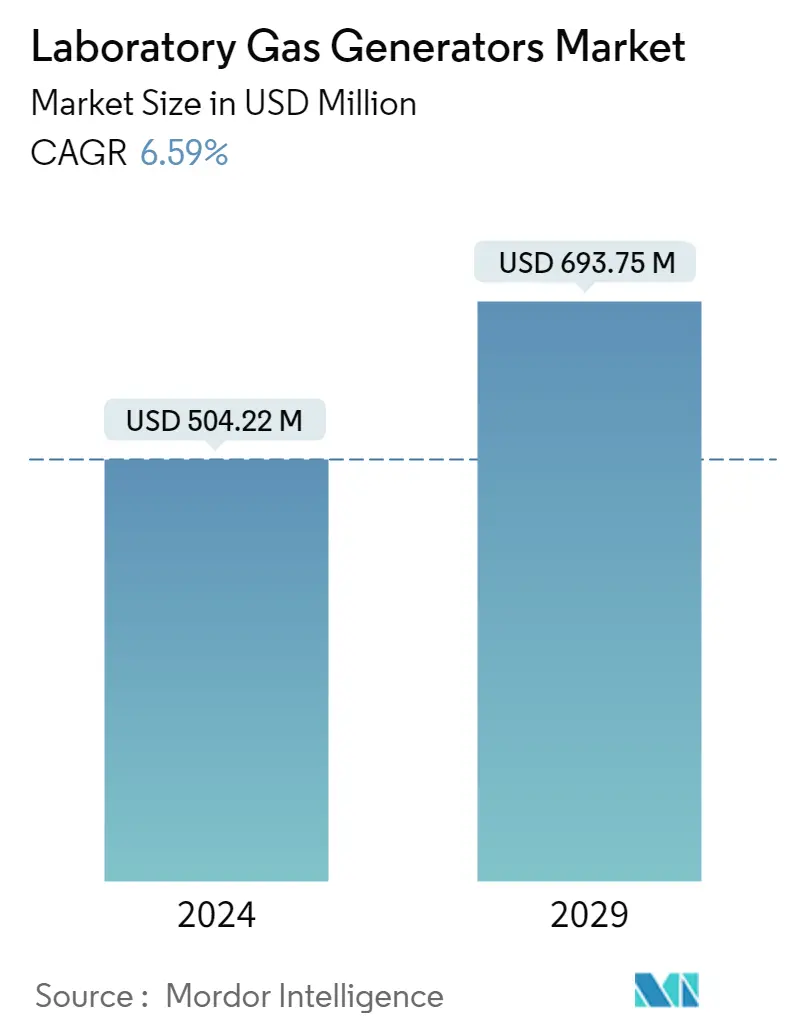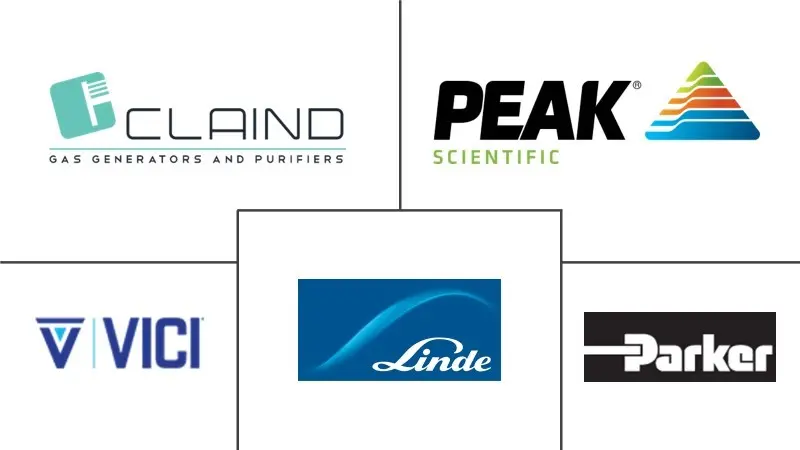Market Size of Laboratory Gas Generators Industry

| Study Period | 2021 - 2029 |
| Market Size (2024) | USD 504.22 Million |
| Market Size (2029) | USD 693.75 Million |
| CAGR (2024 - 2029) | 6.59 % |
| Fastest Growing Market | Asia-Pacific |
| Largest Market | North America |
Major Players
*Disclaimer: Major Players sorted in no particular order |
Laboratory Gas Generators Market Analysis
The Laboratory Gas Generators Market size is estimated at USD 504.22 million in 2024, and is expected to reach USD 693.75 million by 2029, growing at a CAGR of 6.59% during the forecast period (2024-2029).
COVID-19 impacted the laboratory gas generators market due to the disruption of operation and supply chain, decreased customer demand, and global economic slowdown. Thus, the closure of academic institutions and laboratories across the globe has resulted in a significant loss of segmental revenue for businesses. Moreover, the demand for laboratory gas generators increased during the pandemic due to COVID-19-related laboratory-based research and development activity. For instance, in June 2021, Novagenix used PEAK nitrogen generators in their COVID-19 drug discovery study to assess and certify the efficacy and quality of medications in Turkey. Such usage of laboratory gas generators in drug discovery of COVID drove the demand for laboratory gas generators during the pandemic. Thus, the COVID-19 pandemic has boosted the market's growth and is expected to follow the same traction during the forecast period of the study.
The growth in this market is primarily driven by the rising safety concerns related to conventional gas cylinders use, the growing importance of analytical techniques in drug and food approval processes, and increasing R&D spending in target industries.
Analytical chemistry plays a crucial role in drug development, ensuring novel medications' quality, safety, and efficacy. Although several analytical methods are utilized in the pharmaceutical sector, three general analytical techniques are chiefly used to determine the structure, separate analytes, and quantify target compounds. These include chromatography, spectroscopy, and conventional analytical chemistry techniques. The application of analytical testing is growing for detecting and identifying dangerous chemicals, including both adulterants and pharmaceutically active compounds. In this context, the Azo optics article published in March 2022 stated that ultraviolet/visible (UV/Vis) and infrared (IR) spectroscopy are two standard spectroscopic techniques used to quantify the presence of food additives in their finished food items. These two methods can offer crucial details about the chemical composition, textural traits, and quality-related aspects of food additives. Thus, with the increasing spectroscopy use for analytical testing of the food approval process, laboratory gas generators are also expected to increase, thereby boosting the market growth.
Furthermore, high-performance liquid chromatography (HPLC) techniques use stationary phases containing proteins and phospholipids to simulate the biological environment where diffused drug molecules are known as biomimetic chromatography. The article published by European Chemical Societies in April 2022 mentioned using biomimetic chromatographic data to forecast the aquatic toxicity of drugs and pesticides. Such increasing adoption of these analytical techniques is expected to generate the demand for laboratory gas generators, frequently used to perform them, thereby driving the market growth.
Additionally, the PharmaVoice article published in July 2022 stated that in the five years running up to 2022, the biotechnology sector's R&D spending nearly doubled. As the biotechnology labs are a controlled environment, the nitrogen laboratory gas generators are primarily used in such labs. Thus, with the increasing investment in the biotechnology industries, the growth of laboratory gas generators is anticipated.
Moreover, market players are also involved in strategies such as acquisitions, mergers, and product launches, among others. For instance, in August 2022, Tisch Environmental acquired AADCO Instruments (Advanced Analytical Device Company). The company AADCO is developing a state-of-the-art line of Zero Air Generators.
Hence, factors such as the growing importance of analytical techniques in drug and food approval processes, growing R&D expenditure, and increased market player activities such as mergers and acquisitions are expected to witness growth over the forecast period. However, reluctance to replace conventional gas supply methods and lack of skilled personnel is expected to restrain the market's growth.
Laboratory Gas Generators Industry Segmentation
As per the scope of the report, a laboratory gas generator is a system that delivers a continuous supply of purified gas directly to a system. These generators are used in numerous industries, such as petrochemicals, pharma and biotech, and food and beverages. The Laboratory Gas Generators Market is segmented by type (nitrogen gas generators, hydrogen gas generators, zero air generators, TOC gas generators, and other gas generator types), end-user (food and beverage companies, chemical and petrochemical companies, pharmaceutical and biotechnological companies) and geography (North America, Europe, Asia-Pacific, Middle East, and Africa, and South America). The market report also covers the estimated market sizes and trends for 17 countries across major regions globally. The report offers the value in ( USD million) for the above segments.
| By Type | |
| Nitrogen Gas Generators | |
| Hydrogen Gas Generators | |
| Zero Air Generators | |
| TOC Gas Generators | |
| Other Gas Generators |
| By End User | |
| Food and Beverage Companies | |
| Chemical and Petrochemical Companies | |
| Pharmaceutical and Biotechnological Companies |
| Geography | ||||||||
| ||||||||
| ||||||||
| ||||||||
| ||||||||
|
Laboratory Gas Generators Market Size Summary
The laboratory gas generators market is poised for significant growth over the forecast period, driven by increasing safety concerns associated with conventional gas cylinders and the rising importance of analytical techniques in drug and food approval processes. The market experienced a temporary setback due to the COVID-19 pandemic, which disrupted operations and supply chains, but also saw a surge in demand due to heightened laboratory-based research activities. The growing adoption of analytical techniques such as chromatography and spectroscopy, essential for ensuring the quality and safety of pharmaceuticals and food products, is expected to further propel market expansion. Additionally, the biotechnology sector's increased R&D spending and the shift towards advanced nitrogen gas generators, which offer safety and efficiency advantages, are contributing to the market's positive outlook.
North America is anticipated to hold a significant share of the laboratory gas generators market, supported by robust research and development activities in the pharmaceutical industry and a well-established infrastructure. The region's market growth is bolstered by substantial investments in R&D by major pharmaceutical companies and government organizations, which are expected to drive demand for laboratory gas generators. The establishment of advanced manufacturing facilities and the development of new technologies by research organizations and universities further contribute to the market's expansion in North America. The competitive landscape is characterized by the presence of both local and international players, with companies actively engaging in product launches and strategic acquisitions to enhance their market position.
Laboratory Gas Generators Market Size - Table of Contents
-
1. MARKET DYNAMICS
-
1.1 Market Overview
-
1.2 Market Drivers
-
1.2.1 Rising Safety Concerns Related to the Use of Conventional Gas Cylinders
-
1.2.2 Growing Importance of Analytical Techniques in Drug and Food Approval Processes
-
1.2.3 Increasing R&D Spending in Target Industries
-
-
1.3 Market Restraints
-
1.3.1 Reluctance to Replace Conventional Gas Supply Methods
-
1.3.2 Lack of Skilled Personnel
-
-
1.4 Porter's Five Forces Analysis
-
1.4.1 Bargaining Power of Suppliers
-
1.4.2 Bargaining Power of Buyers/Consumers
-
1.4.3 Threat of New Entrants
-
1.4.4 Threat of Substitute Products
-
1.4.5 Intensity of Competitive Rivalry
-
-
-
2. MARKET SEGMENTATION (Market Size by Value - USD Million)
-
2.1 By Type
-
2.1.1 Nitrogen Gas Generators
-
2.1.2 Hydrogen Gas Generators
-
2.1.3 Zero Air Generators
-
2.1.4 TOC Gas Generators
-
2.1.5 Other Gas Generators
-
-
2.2 By End User
-
2.2.1 Food and Beverage Companies
-
2.2.2 Chemical and Petrochemical Companies
-
2.2.3 Pharmaceutical and Biotechnological Companies
-
-
2.3 Geography
-
2.3.1 North America
-
2.3.1.1 United States
-
2.3.1.2 Canada
-
2.3.1.3 Mexico
-
-
2.3.2 Europe
-
2.3.2.1 Germany
-
2.3.2.2 United Kingdom
-
2.3.2.3 France
-
2.3.2.4 Italy
-
2.3.2.5 Spain
-
2.3.2.6 Rest of Europe
-
-
2.3.3 Asia-Pacific
-
2.3.3.1 China
-
2.3.3.2 Japan
-
2.3.3.3 India
-
2.3.3.4 Australia
-
2.3.3.5 South Korea
-
2.3.3.6 Rest of Asia-Pacific
-
-
2.3.4 Middle East and Africa
-
2.3.4.1 GCC
-
2.3.4.2 South Africa
-
2.3.4.3 Rest of Middle East and Africa
-
-
2.3.5 South America
-
2.3.5.1 Brazil
-
2.3.5.2 Argentina
-
2.3.5.3 Rest of South America
-
-
-
Laboratory Gas Generators Market Size FAQs
How big is the Laboratory Gas Generators Market?
The Laboratory Gas Generators Market size is expected to reach USD 504.22 million in 2024 and grow at a CAGR of 6.59% to reach USD 693.75 million by 2029.
What is the current Laboratory Gas Generators Market size?
In 2024, the Laboratory Gas Generators Market size is expected to reach USD 504.22 million.

